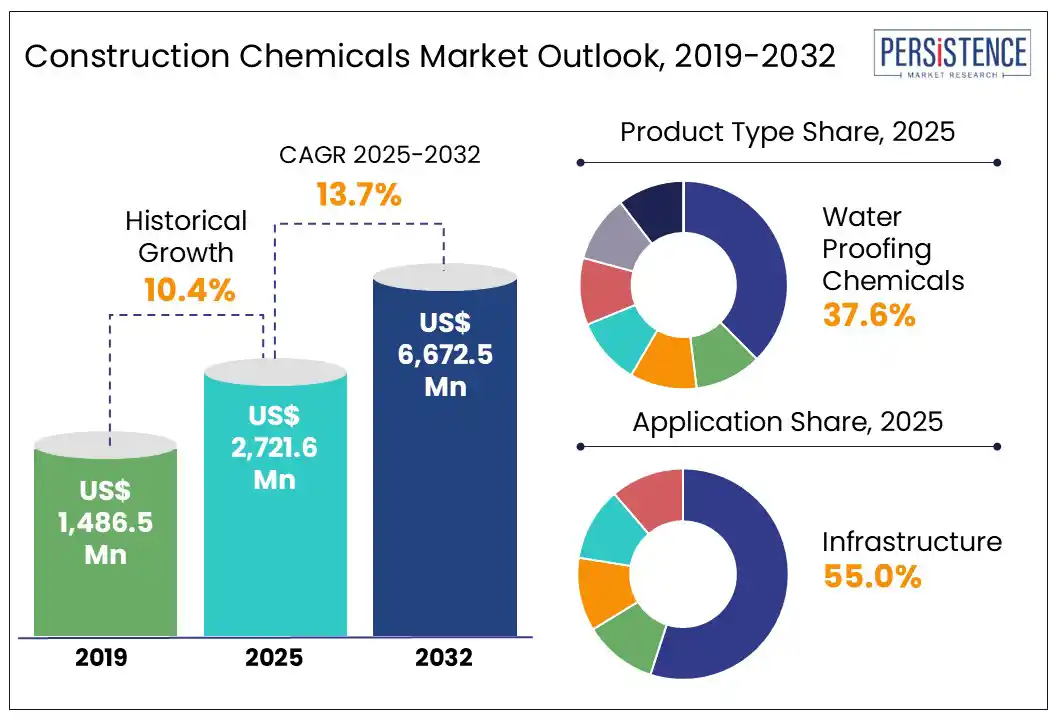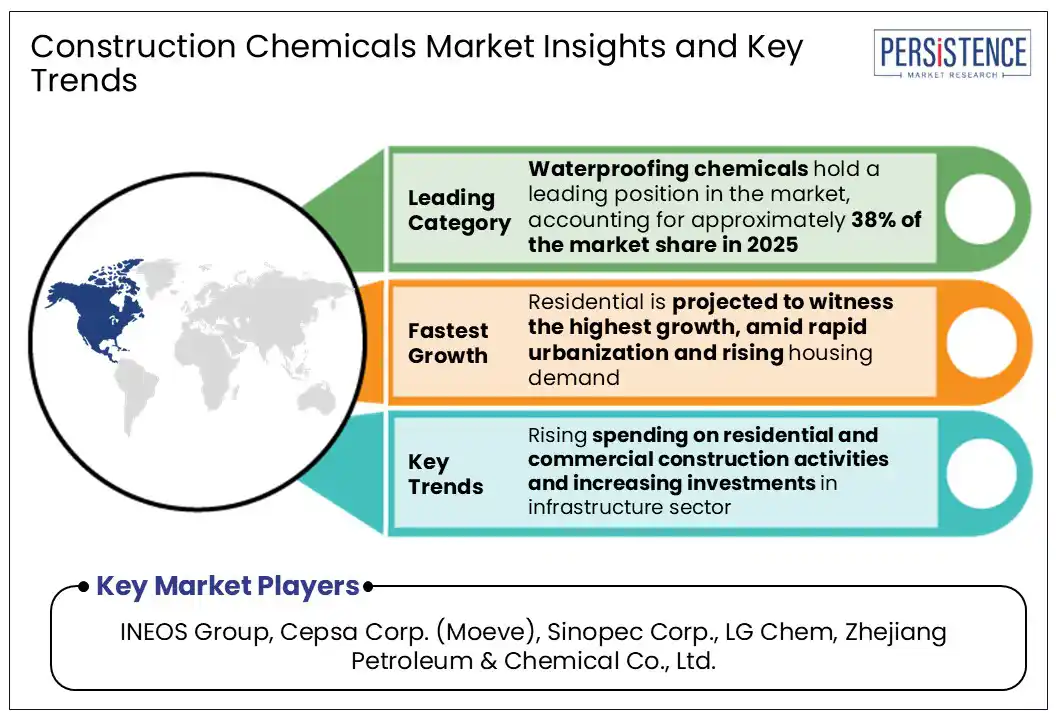ID: PMRREP3182| 191 Pages | 8 Jul 2025 | Format: PDF, Excel, PPT* | Chemicals and Materials

The global construction chemicals market size is likely to be valued at US$ 59.4 billion in 2025 and is expected to reach US$85.8 billion by 2032, growing at a CAGR of 5.4% from 2025 to 2032. This growth is primarily driven by rising demand for high-performance, durable, and sustainable construction materials across residential, commercial, and infrastructure sectors.
Robust infrastructure development and urbanization, increasing investment in smart city and infrastructure projects, and the growing adoption of precast and modular construction techniques are significantly contributing to market expansion. Moreover, the global push for green building practices and environmentally friendly construction solutions is driving the use of low-VOC adhesives, waterproofing systems, concrete admixtures, and other specialty chemicals that enhance structural strength, energy efficiency, and durability.

Key Industry Highlights:
|
Global Market Attribute |
Key Insights |
|
Construction Chemicals Market Size (2025E) |
US$59.4 Bn |
|
Projected Market Value (2032F) |
US$85.8 Bn |
|
Global Market Growth Rate (CAGR 2025 to 2032) |
5.4% |
|
Historical Market Growth Rate (CAGR 2019 to 2024) |
3.9% |
The global construction chemicals market is experiencing significant growth, fueled by rapid urbanization and an increase in infrastructure development, especially in emerging economies. As populations increasingly migrate to urban centers, the demand for essential infrastructure, such as roads, bridges, airports, and buildings, has surged, particularly in regions such as Asia Pacific, Latin America, and Africa.
According to the United Nations, by 2050, 68% of the world's population is expected to live in urban areas, necessitating the construction of approximately 2 billion new homes. In response, manufacturers are expanding production capacities and establishing regional facilities. For instance, Sika AG opened a new plant in Bolivia in 2024, doubling its production capacity for mortar and concrete admixtures. Similarly, Saint-Gobain acquired FOSROC, thereby enhancing its footprint in India, the Middle East, and the Asia Pacific.
These strategic movements underscore manufacturers' commitment to capitalizing on the booming infrastructure sector, offering advanced chemicals that improve construction efficiency and ensure structural longevity in rapidly urbanizing regions.
Stringent environmental regulations and compliance challenges are significantly affecting the global construction chemicals market. Key regulations, such as the European Union’s REACH and the U.S. Environmental Protection Agency’s VOC emission limits, require the reformulation of critical products like adhesives, sealants, and coatings to decrease harmful emissions. This often results in increased production costs, up to 25%, as low-VOC or bio-based chemicals demand expensive raw materials and advanced processing techniques.
Non-compliance can lead to severe penalties or market bans, particularly in Europe and North America, where oversight is strict. In 2023, the EU heightened its chemical safety standards, requiring detailed environmental impact data, which strains smaller companies with limited resources.
While leading manufacturers like Fosroc and Saint-Gobain are making substantial investments in compliance, Fosroc introduced eco-friendly waterproofing solutions in 2023, and Saint-Gobain acquired Chryso in 2021; these measures can drive up product prices, hindering adoption in cost-sensitive markets.
This regulatory burden stifles innovation and limits market expansion, particularly for small manufacturers that struggle to manage compliance costs, ultimately restraining overall market growth. Addressing these challenges is essential for fostering a sustainable and competitive industry.
The increasing demand for green building certifications, such as LEED and BREEAM, is creating significant opportunities for the global construction chemicals market, as developers prefer eco-friendly materials to meet sustainability goals. With the construction sector accounting for approximately 39% of global carbon emissions, according to the International Energy Agency, governments and consumers are pushing for low-carbon, energy-efficient buildings.
Eco-friendly construction chemicals, including low-VOC adhesives, bio-based sealants, and sustainable concrete admixtures, are critical for achieving these certifications, which enhance property value and appeal. Saint-Gobain’s acquisitions of FOSROC in June 2024 and Ovniver Group in August 2024 strengthen its portfolio of sustainable solutions, with FOSROC’s eco-friendly waterproofing systems gaining traction in India’s green residential projects.
Thermax’s October 2024 acquisition of Buildtech Products India Private Limited bolsters its offerings in low-carbon admixtures for infrastructure, aligning with India’s sustainability mandates. These strategic initiatives reflect manufacturers’ focus on developing products that reduce environmental impact while meeting regulatory standards such as the EU’s REACH framework.
By expanding production of bio-based and recycled-content chemicals, companies can capture market share in regions with strong green building policies, such as Asia Pacific and Europe, and cater to the growing consumer preference for sustainable construction, driving long-term growth and profitability.
A prominent trend in the global construction chemicals market is the increasing focus on strategic acquisitions and geographic expansion by leading manufacturers to strengthen their presence in high-growth emerging markets, such as India, the Middle East, Asia Pacific, Latin America, and Africa.
For instance, Saint-Gobain’s August 2024 acquisition of Ovniver Group in Mexico and Central America strengthens its position in Latin America, aligning with its goal to lead in sustainable construction. Sika AG’s acquisition of Vinaldom, S.A.S in the Dominican Republic in May 2024 enhances its market share in the Caribbean, enabling cross-selling of high-quality concrete products.
In April 2025, Mapei Group further exemplifies this trend with the opening of a 30,000-square-meter production plant in Egypt to produce adhesives and mortars for local markets, and in October 2024, the acquisition of Wykamol in the UK to enhance its waterproofing offerings.
These strategic moves reflect a broader industry shift toward consolidating expertise, expanding production capacities, and tailoring sustainable solutions to meet regional demands, positioning companies to drive innovation and capture significant market share in the rapidly growing construction chemicals sector.

Based on product type, waterproofing chemicals are expected to account for nearly 21% share of the global construction chemicals market in 2025, owing to their essential role in enhancing the durability, safety, and structural integrity of buildings and infrastructure. These chemicals are widely used in rooftops, basements, tunnels, water tanks, and other critical structures to prevent water seepage, which can lead to corrosion, weakening of concrete, and costly repairs. Their versatility, available in forms such as membranes, coatings, and crystalline compounds, makes them indispensable in modern construction practices.
The concrete admixtures segment is projected to be the fastest-growing product category and is expected to create a million-dollar absolute opportunity from 2025 to 2032. These admixtures, ranging from plasticizers and superplasticizers to accelerators and retarders, are designed to modify the properties of concrete during mixing, curing, and setting, resulting in improved strength, workability, and durability. Innovations in admixture formulations that support low-carbon and high-strength concrete are attracting significant market interest, especially in developed regions and environmentally conscious markets.
In 2025, the infrastructure segment is expected to dominate the global construction chemicals market, capturing an estimated 23% market share, driven by large-scale public and private sector investments in transportation, energy, and water management systems. Governments across developed and emerging economies are infrastructure modernization, including roads, bridges, tunnels, railways, and airports, which require substantial volumes of construction chemicals such as concrete admixtures, waterproofing systems, sealants, and repair materials.
The residential segment is projected to experience the highest growth rate by 2032. This is attributed to the rising urbanization, population growth, and increased housing demand, particularly in fast-developing countries across Asia Pacific, Africa, and Latin America.
Asia Pacific is expected to lead the construction chemicals market, driven by rapid urbanization, infrastructure expansion, and the development of industrial facilities. It is expected to account for nearly 25% share of the global market in 2025. The rise in urban population in countries such as China, India, and Southeast Asia drives the demand for roads, bridges, metro systems, utilities, and high-rise commercial buildings.
Major initiatives such as China's Belt and Road projects, India's Smart Cities Mission, and ASEAN's smart infrastructure upgrades are key factors supporting the market growth. For example, India’s infrastructure spending is projected to reach approximately 3.3% of GDP in 2024 and continue to rise with ongoing projects in highways, metros, and affordable housing. These trends are positioning Asia Pacific as a key market for the construction chemicals industry, with strong demand for products such as concrete admixtures, waterproofing agents, and repair materials.
North America's construction chemicals market is experiencing steady growth, fueled by a well-established construction industry and increasing emphasis on sustainable and high-performance building practices. The ongoing wave of residential renovations and new home constructions continues to support demand for tile adhesives, sealants, waterproofing solutions, and concrete admixtures. In 2024, the total value of construction put in place in the United States reached an estimated US$ 2.1 trillion, marking a 6.5% increase over 2023.
The North American construction industry is significantly influenced by green building standards, such as LEED and Energy Star, which are encouraging contractors and developers to adopt eco-friendly construction chemicals that have low VOC emissions and improved durability. Robust increases in mega infrastructure projects, such as highway rehabilitation, airport upgrades, and smart city initiatives, are being driven by both federal funding (e.g., the U.S. Infrastructure Investment and Jobs Act) and private sector investment is also expected to drive the North American construction chemicals market.
The Middle East and Africa (MEA) region is projected to emerge as one of the most promising markets for construction chemicals, driven by increasing urbanization, population growth, and robust infrastructure investment. In 2024, the Gulf Cooperation Council (GCC) countries awarded construction contracts worth US$273 billion, marking a 9.6% increase from 2023 and signaling strong market recovery and investor confidence. Saudi Arabia led this surge, accounting for 53.8% of the total GCC awards with US$146.8 billion in contracts, driven largely by its ambitious Vision 2030 agenda and transformative mega-projects such as NEOM, The Line, and Red Sea Global.
Moreover, with rising awareness of energy efficiency and environmental standards, there is growing traction for sustainable, energy-saving solutions, such as cool roof coatings and low-emission adhesives. While the market is still developing in parts of Africa, key manufacturers are expanding operations and forming local partnerships to tap into this high-potential region.
The global construction chemicals market is moderately fragmented, with the presence of Tier I, Tier II, and Tier III players competing across various segments. Leading companies such as Sika AG, Saint-Gobain, Mapei, The 3M Company, and Pidilite Industries collectively hold around 30–35% of the global market share.
These key players are focused on strategic acquisitions, regional expansion, R&D investment, and sustainability to strengthen their market positions in emerging regions. Key trends among competitors include the development of eco-friendly and high-performance products, digitalization of technical services, and integrated solutions aimed at enhancing construction efficiency and long-term durability.
The global construction chemicals market is projected to be valued at US$ 59.4 Bn in 2025.
Key growth drivers include rising demand for high-performance, durable, and sustainable construction materials across residential, commercial, and infrastructure sectors.
The construction chemicals market is poised to witness a CAGR of 5.4% from 2025 to 2032.
Rising Demand for green building certifications creates opportunities for eco-friendly construction chemicals.
Major players in the construction chemicals market include Sika AG, Saint Gobain, Mapei, The 3M Company, Arkema Group, and others.
|
Report Attribute |
Details |
|
Forecast Period |
2025 to 2032 |
|
Historical Data Available for |
2019 to 2024 |
|
Market Analysis |
Kilo Tons for Volume US$ Billion for Value |
|
Key Regions Covered |
|
|
Key Market Segments Covered |
|
|
Key Companies Profiled in the Report |
|
|
Report Coverage |
|
|
Customization & Pricing |
Available upon request |
By Product Type
By Application
By Region
Delivery Timelines
For more information on this report and its delivery timelines please get in touch with our sales team.
About Author